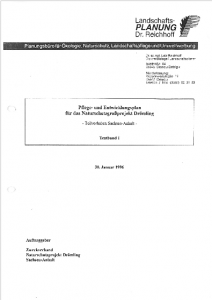Maintenance and development plans are classic working tools of nature conservation administrations. On a technical basis, they represent transparent and legally binding working principles for nature conservation administrations. The care and development plan for the Drömling was drawn up as part of the large-scale nature conservation project in Drömling/Saxony-Anhalt. Due to the associated funding obligations towards the Federal Republic of Germany, this planning instrument has further binding effects for other specialist administrations as well. Changes or updates must be coordinated with the Federal Agency for Nature Conservation as the competent federal authority or have them confirmed by them.
Of the formerly approximately 12,000 to 15,000 hectare of bog soil, around one third, i. e. 9,400 hectares of varying quality, still exists. Approximately 4,400 hectares are still genuine bog soil and approximately 5,000 hectares degraded (gley soil).
Therefore, the most important task and at the same time the biggest challenge for the Droemling is to secure the remaining fenland in the long term by adapting groundwater levels and temporarily flooding during the winter months. The implementation is carried out in such a way that settlement areas are not affected.
The grassland, which is typically structured by ditches, flood channels and hedges, is to be developed and secured as a habitat for specific animal and plant species such as white stork, lapwing and moor frog or cabbage thistle, marsh marigold and cotton grass.
The prerequisite is to create appropriate groundwater conditions. Currently, you find genuine wet meadows on about 240 hectares. The area’s diversity of amphibians is demonstrated by the population density of more than 40 breeding pairs of white stork.
Near-natural forest development is legally determined in the Droemling, especially in the 900 hectares of total reserves. In addition, the approximately 480 hectares of woodland belonging to the Association are being developed into near-natural forests.
When the silvicultural exploitation was discontinued, well-structured forest edges were created to a large extent. In the meantime, the crane has conquered many of these forests as breeding grounds. The most important forest types are alder-ash and oak-hornbeam as well as alder carr.
The main watercourse of the Saxony-Anhalt Droemling, the Ohre creek, consisted before cultivation of a ramified water network without recognizable course. In several stages, the Ohre creek was extended in the shape of a canal, a number of drainage ditches were built and weirs were gradually erected to regulate the water levels.
It is no longer possible to return to the original fine structure of the water system. However, the main watercourses are to be structurally upgraded and ecologically penetrated to such an extent that the now typical fish and other aquatic fauna is protected and promoted with, among other things, misgurnus and crucian carp.
The Droemling represents a unique cultural landscape with development stages still visible today. To be outdoors in the bosom of nature and the scenic beauty combined explain the suitability of the site for recreational use. However, the basis for tourist use is the discernment with regard to ecological compatibility.
The concept of “gentle tourism” is aimed to experience the typical landscape and to observe Mother nature as well as to develop settlements involving their cultural heritage of buildings and to link agricultural offers.
Kurzfassung des Pflege- und Entwicklungsplans für den Drömling 2015.
Mit der Broschüre wurden die Inhalte der naturschutzfachlichen Planungen für das Gebiet in allgemein verständlicher Form zusammengefasst und erläutert. Darüber hinaus wurde der Inhalt um historische Fakten ergänzt sowie aktuelle Problemfelder und Lösungsansätze des Naturschutzes im Drömling beschrieben. Die Broschüre ist kostenlos erhältlich. Auftraggeber war der Zweckverband.
Pflege- und Entwicklungsplan (PEP) für das Naturschutzgebiet Ohre-Drömling als Grundlage für die Aufstellung von Managementplänen (MAP) für die FFH- und Vogelschutzgebiete im Naturpark Drömling (Fortschreibung).
Die Planung stellt in Teilen auch eine Fortschreibung des bisherigen Pflege- und Entwicklungsplanes dar. Auftraggeber war das Landesverwaltungsamt (Naturparkverwaltung Drömling) des Landes Sachsen-Anhalt.








